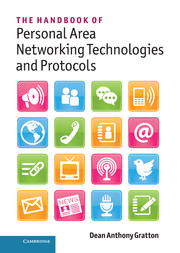Book contents
- Frontmatter
- Dedication
- Contents
- About the Author
- Making My Book Social
- Acknowledgements
- Before We Begin
- About This Book
- Part I What's In Your Area Network?
- 1 It's a Small Wireless World
- 2 What is a Personal Area Network?
- 3 Disruptive Topologies through Technology Convergence
- 4 Introducing the Lawnmower Man Effect
- Part II The Wireless Sensor Network
- Part III The Classic Personal Area Network
- Part IV Forthcoming Technologies and Conclusions
- Glossary
- References and Bibliography
- Index
2 - What is a Personal Area Network?
from Part I - What's In Your Area Network?
Published online by Cambridge University Press: 05 September 2013
- Frontmatter
- Dedication
- Contents
- About the Author
- Making My Book Social
- Acknowledgements
- Before We Begin
- About This Book
- Part I What's In Your Area Network?
- 1 It's a Small Wireless World
- 2 What is a Personal Area Network?
- 3 Disruptive Topologies through Technology Convergence
- 4 Introducing the Lawnmower Man Effect
- Part II The Wireless Sensor Network
- Part III The Classic Personal Area Network
- Part IV Forthcoming Technologies and Conclusions
- Glossary
- References and Bibliography
- Index
Summary
The personal area networking space may nowadays encompass a personal computer and may include a diverse collection of other peripherals or gadgets, where each serves a unique purpose within the personal topology. Let's not forget that, first and foremost, a Personal Area Network (PAN) is a term used to describe a particular networking topology (we include in Table 2.1 further examples of networking topologies). The Wireless Personal Area Network (WPAN) has offered us a diverse collection of short-range radio technologies, which have had an influence on the dynamics of the personal area network, and we will explore this later. The PAN is a relatively new term to the computing industry, probably appearing about two decades ago or so. This chapter aims to provide a conclusive and modern definition of the PAN, by drawing on several attributes and technologies that have already influenced the network space, as well as potentially dissolving its boundaries. In fact, in Chapter 3, “Disruptive Topologies through Technology Convergence,” and Chapter 4, “Introducing the Lawnmower Man Effect,” we look at the diversification of the PAN domain, where social (media) networking has extended what was once a private space into several virtual communities that have supported technology-enabled socializing. Furthermore, Section 2.3, “Ever-decreasing Circles,” looks at the increasingly blurred PAN topology and how the boundaries that separate one topology from another are rapidly dissolving. But first we look at the origin of the area network and other networking topologies that have characterized the way we perceive network interconnection and uniquely how we have come to understand them.
- Type
- Chapter
- Information
- Publisher: Cambridge University PressPrint publication year: 2013



